
The Paraguayan War, also known as the War of the Triple Alliance, was a South American war that lasted from 1864 to 1870. It was fought between Paraguay and the Triple Alliance of Argentina, the Empire of Brazil, and Uruguay. It was the deadliest and bloodiest inter-state war in Latin American history. Paraguay sustained large casualties, but the approximate numbers are disputed. Paraguay was forced to cede disputed territory to Argentina and Brazil. The war began in late 1864, as a result of a conflict between Paraguay and Brazil caused by the Uruguayan War. Argentina and Uruguay entered the war against Paraguay in 1865, and it then became known as the "War of the Triple Alliance."

The Battle of Tuyutí was a Paraguayan offensive in the Paraguayan War targeting the Triple Alliance encampment of Tuyutí. It is considered to be the bloodiest battle ever in South America. The result of the battle was an Allied victory, which added to the Paraguayan troubles after the loss of its fleet in the Battle of Riachuelo.
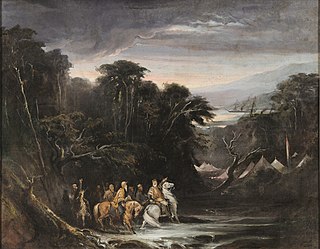
The Pikysyry maneuver was a tactic used by Brazilian marshal Luís Alves de Lima e Silva, Duke of Caxias, during the Paraguayan War to outflank the Paraguayan southern defense line along the stream of Pikysyry consisting of 142 gun platforms along a line 9.1 km long, built by the British engineer Lt. Col. George Thompson. Just to the north were the batteries of Angostura, protecting the River Paraguay. Marshal Caxias decided to attack from the Paraguayan rear by constructing a 10.7 km road on the Chaco side of the river starting at Santa Theresa.
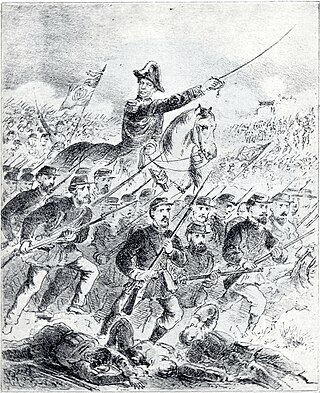
On the morning of 6 December 1868, marshal of the Imperial Brazilian Army, Luís Alves de Lima e Silva, Marquis of Caxias, moved with 16,999 infantrymen, 926 cavalrymen and 742 artillerymen, to take Villeta, a Paraguayan city, as a plan to make further attacks on the Paraguayan Army rear. Nevertheless, Paraguayan president and commander-in-chief of the army Francisco Solano López was aware of the landing the Allies had made in the rear of his army.

The Battle of Acosta Ñu or Campo Grande took place during the Paraguayan War, fought on 16 August 1869, between the Triple Alliance and Paraguay. The 3,500 poorly armed Paraguayans, mostly boys between nine and 15 years old, old men and wounded combatants, confronted 20,000 Brazilian and Argentine veteran soldiers.

The military history of Brazil comprises centuries of armed actions in the territory encompassing modern Brazil, and the role of the Brazilian Armed Forces in conflicts and peacekeeping worldwide. For several hundreds of years, the area was the site of intertribal wars of indigenous peoples. Beginning in the 16th century, the arrival of Portuguese explorers led to conflicts with the aboriginal peoples; a notable example being the revolt of the Tamoio Confederation. Sporadic revolts of African slaves also marked the colonial period, with a notable rebellion led by Zumbi dos Palmares. Conflicts were encountered with other European nations as well – two notable examples being the France Antarctique affair, and a conflict with the Netherlands in the early 17th century over control of much of the Northeast. Although Portugal retained its possessions during conflicts with other nations, it lost control of the colony after the Brazilian war of Independence, which led to the establishment of the Empire of Brazil.

The Battle of Cerro Corá was the last battle of the Paraguayan War, fought on 1 March 1870, in the vicinity of Cerro Corá, 454 kilometres (280 mi) northeast of Paraguay's capital Asunción. It is known for being the battle in which Francisco Solano López, Paraguayan president, was killed at the hands of the Imperial Brazilian Army.

The Battle of Estero Bellaco was one of the bloodiest battles of the Paraguayan War. The battle was fought on 2 May 1866 with the Paraguayan Army suffering 2,000 casualties among the dead and wounded. Likewise, 300 of their men were taken prisoner by the troops belonging to the Triple Alliance: Argentina, Brazil and Uruguay. The allies lost nearly 2,000 men, mostly wounded, and the Uruguayan troops of General Venancio Flores - commanded by León de Palleja - were severely decimated, accounting for the vast majority of allied deaths.

Manuel Marques de Sousa, Count of Porto Alegre, nicknamed "the Gloved Centaur", was an army officer, politician and abolitionist of the Empire of Brazil. Born into a wealthy family of military background, Manuel Marques de Sousa joined the Portuguese Army in Brazil in 1817 when he was little more than a child. His military initiation occurred in the conquest of the Banda Oriental, which was annexed and became the southernmost Brazilian province of Cisplatina in 1821. For most of the 1820s, he was embroiled in the Brazilian effort to keep Cisplatina as part of its territory: first during the struggle for Brazilian independence and then in the Cisplatine War. It would ultimately prove a futile attempt, as Cisplatina successfully separated from Brazil to become the independent nation of Uruguay in 1828.

Manuel Luís Osório, Marquis of Erval was a Brazilian military officer, monarchist and politician. A member of the Imperial Army at the age of fifteen, he climbed all the posts of the military hierarchy of his time thanks to the soldier attributes that consecrated him as "The Legendary". He participated in the main military events of the late nineteenth century in the Río de la Plata region and is considered a hero of the Paraguayan War. He was declared patron of the Cavalry Branch of the Brazilian Army in 1962.
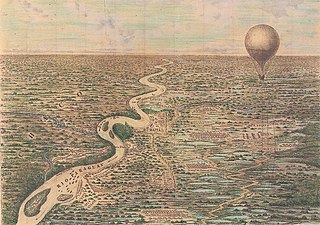
The siege of Humaitá was a military operation in which the Triple Alliance flanked, besieged and captured the Fortress of Humaitá, a Paraguayan stronghold that was referred to as the Gibraltar of South America. It fell on 26 July 1868. It can be considered the key event of the Paraguayan War since the fortress had frustrated the allied advance into Paraguay for more than two years. However it did not surrender as the defenders escaped, most of them to fight another day.
Below is the timeline of Paraguayan history.
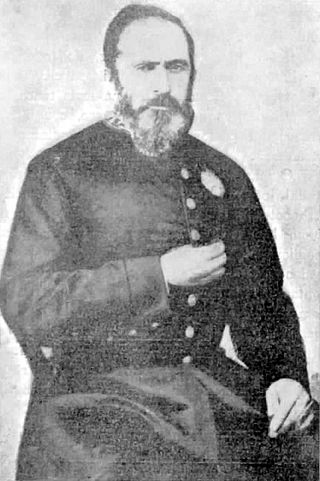
José Luís Mena Barreto was an army officer, politician and monarchist of the Empire of Brazil. He came from a wealthy family with a tradition of military service. José Luís entered the army in 1836, during the Ragamuffin War, a secessionist rebellion. The conflict lasted for almost ten years, and he fought in several military engagements at that time.

The Battle of Boquerón was fought on 16 July 1866 and the Battle of Sauce on 18 July 1866, between an allied force of Uruguayans, Brazilians, and Argentines on one side and Paraguay on the other in the Paraguayan War. The Spanish-born Uruguayan officer León de Pallejas (1816–1866) and the Paraguayan officer Elizardo Aquino were killed in the battle.

The Campaign of the Hills was the last campaign of the Paraguayan War, lasting from July 1869 to the end of the war on March 1, 1870. The Paraguayans were completely defeated by the Allies. Brazilian writer Alfredo d'Escragnolle Taunay, Viscount of Taunay took part in the campaign and later wrote about it. At least 5,000 Paraguayans were killed during this campaign.
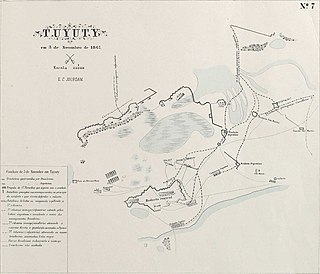
The Second Battle of Tuyutí was fought on 3 November 1867 between the Paraguayan Army and a smaller allied Brazilian-Argentine force. The Paraguayans lost twice as many soldiers as the allies and were defeated.

The Battle of Lomas Valentinas was fought in the Central Department of Paraguay on December 21–27, 1868. The Paraguayan Army, led personally by president Francisco Solano López, were decisively defeated, though López managed to escape. On 30 December 1868, the Paraguayan garrison at Angostura, with 1,907 men, surrendered to the Allies.

The Battle of Perecué, also known as Battle of Tayí Island, was an armed action that occurred during the Paraguayan War. Paraguayan general Bernardino Caballero's troops launched guerrilla-style raids on the Allied encampment in the Tayí area, near the Humaitá Fortress. The Marquis of Caxias, Luís Alves de Lima e Silva, who had replaced Bartolomé Mitre in the supreme command of allied troops, learned of the Paraguayan presence in the area and prepared a counterattack on his enemies, failing in this action that resulted in a pyrrhic victory of the Paraguayans.

The Humaitá campaign or the Cuadrilátero campaign was the third, longest and deadliest campaign of the Paraguayan War. The campaign lasted from 16 April 1866 to 5 August 1868. After the initial Paraguayan success in the Mato Grosso campaign and its failure in the Corrientes campaign, the armed forces of the Triple Alliance, Argentina, the Empire of Brazil and Uruguay, invaded the south of Paraguay. At a very short distance, they found the Paraguayan defensive device made up of four fortifications, the so-called "Cuadrilátero", which obstructed the passage to Asunción both by land and by the Paraguay River. A long series of battles cost huge numbers of casualties on both sides, with operations coming to a complete halt after the allied defeat at the Battle of Curupayty. Casualties on both sides were even higher from disease than from battle due to a cholera epidemic which was added to the appalling food and sanitary conditions.

The assault on the battleship Barroso and the monitor Rio Grande, also known as assault on the battleships at Tagy, was a Paraguayan naval operation carried out during the Paraguayan War. The Imperial Brazilian Navy was present in the main actions of the allied forces. President Francisco Solano López knew of the threat that the navy posed and wanted to capture some of its ships, the ironclads. The seizure was also seen as a form of compensation for the losses incurred as a result of the war. Assault plans were created and executed in 1868.



















